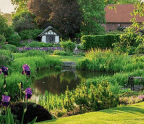HIDDEN LONDON


Patchwork Tudor bricks, sturdy Victorian mouldings, cobbled courtyards and majestic cloisters; the ancient Charterhouse hides some of London’s more surprising secrets. For centuries it sheltered behind lofty walls, a mystery even to locals. Tantalising glimpses of fig trees and climbing roses, higgledy-piggledy roofs and tall brick chimneys served only to enhance the romantic tales of medieval monks, Lord Mayors and mulberries.
That mystique remains, but it is now possible for mere mortals to peep behind the heavy wooden doors to these beautiful gardens, where the visitor will learn something strange: the gardens aren’t actually all that old. “There wasn’t really anything here when I turned up,” says acting head gardener Claire Davies, “so we spent nine years creating it.”
The estate, just north of the Barbican, was originally designated as a burial
You’re reading a preview, subscribe to read more.
Start your free 30 days





